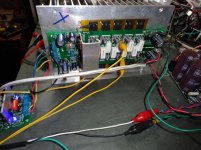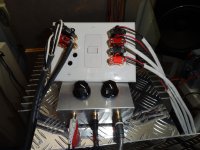Mine turned out pretty well. These are going in a plate amp. I don't want the drivers to break off from the vibration.
I did a very similar bracket in my first build, though your turned out much nicer.
I did a very similar bracket in my first build, though your turned out much nicer.
I saw yours. Thanks for the idea.
Hi Valery,
When you get a chance, could you please check the voltage rtg of ND and PD? I have something wrong but can't find it. With 820R in R107 it still has 14mV across a pair of emitter resistors but will bias to 26mV using the pot. However when I hook up any IPS, it will only hold bias with the input open. As soon as I either short the input or plug in a source,the bias goes through the roof. I think 4v at PD/ND is wrong.
When you get a chance, could you please check the voltage rtg of ND and PD? I have something wrong but can't find it. With 820R in R107 it still has 14mV across a pair of emitter resistors but will bias to 26mV using the pot. However when I hook up any IPS, it will only hold bias with the input open. As soon as I either short the input or plug in a source,the bias goes through the roof. I think 4v at PD/ND is wrong.
Last edited:
Hi Valery,
When you get a chance, could you please check the voltage rtg of ND and PD? I have something wrong but can't find it. With 820R in R107 it still has 14mV across a pair of emitter resistors but will bias to 26mV using the pot. However when I hook up any IPS, it will only hold bias with the input open. As soon as I either short the input or plug in a source,the bias goes through the roof. I think 4v at PD/ND is wrong.
Hi Terry,
I have measured the voltage between PD+ and ND-, got 7.94V there.
RTG is +4.08V and -3.86V respectively. That's ok for FET OPS.
It looks like you get oscillation as soon as you connect an IPS.
I would hook up an oscilloscope to the output to see what exactly is going on there...
What value of CSA and CSB do you have installed?
33p in each.
I will hook up the scope and see what I can.
Feeling a little silly. I guess I have a couple bum IPS. I grabbed a different one and no problems. Weird, all of the IPS were previously tested and worked fine. Going to have to go through all of them again and see what's up. So I have had them playing for about an hour now using the BV modded CFA-XH. Sounds really nice. With the 820R resistors the lowest the bias will go is 20mV across a pair of emitters. Probably need to use the 500R pots if you want to dial it lower. I have it adjusted to 26mV. Runs pretty warm on the heatsinks I have them on. I have a fan pointed at them and they are fine.
Thanks again for all your help. I suppose this offers another avenue. Sounds pretty much the same as the BJT setup from what I can determine so far. I'll try to get my other PSU set up soon so I can A/B between Slewmasters.
Blessings, Terry
Thanks again for all your help. I suppose this offers another avenue. Sounds pretty much the same as the BJT setup from what I can determine so far. I'll try to get my other PSU set up soon so I can A/B between Slewmasters.
Blessings, Terry
Attachments
I would think that most modern CD players could drive the amplifier directly instead of having the preamp in between. I have done that many times, CD direct without any intermediary stage. I think most CD players are capable of 2V output and some even more. Unless you are using an external D/A converter what gain is there in adding another stage.
You'd still need a passive attenuator for volume control (unless the CD player has one in-built) but could possible bypass the buffer, I agree.
Have you experimented Terry? Interested in your observations.
Of course. I used to use the CD directly into the two attenuators. I added the B1 a while back to allow me to use different sources without having to unplug. The B1 has 6 pair of inputs and is very transparent. Easy enough to remove it from the signal chain if that would make folks more comfortable.
I understand if you are switching from a radio to CD and perhaps playing vinyl, it is just that I am wondering how much the preamp is influencing the similarity between all the different input stages and now even a change to the mosfet output stage. My Sony ES CD player does include a volume control so I don't need to add any type of external volume control. My Parasound amps also have amplifier gain stage controls but I think they are pretty lousy sounding amps.
If you are really concerned about the differences is sound between topologies, you really should invest a little time and money and build a good A/B setup. Most won't because they prefer to believe they can hear even subtle differences from memory. That's fine. If folks don't want to hear my opinions, they shouldn't ask for them. I enjoy the challenge of the build and the trouble shooting they seem to always need. With each new build, I learn something and usually make new friends in the process. I mainly use the A/B setup now just to make sure the newest amp build is "up to snuff". All of the Slewmaster combos I have built so far are really stellar sounding amps. I would be proud to present any of them to a friend and know they would be floored at what they hear. Really.
Blessings, Terry
Blessings, Terry
Terry can you post a picture of your AB test setup? Are you using a normal switch to change between amps? How about a simple parts list and sketch wiring drawing of what you are doing. I believe in true blind testing and hopefully you can't tell which amp is on at any given moment. At least they look the same so you shouldn't be influenced by the sight of either amp. Is it a simple AB setup or can you do an ABX where it is a random unknown change?
Hi Kind,
I am attaching some pics. One is a diagram of how the pots are wired. The other is a pic of the actual setup. The source is fed to the center pair of RCA. The left pair go to one amp and the right pair go to the other. Both amps are fed the exact same source continually and the pots are used to equalize the outputs of each amp. The output of each amp is then sent to the speaker switch at the top of the picture. It uses a simple push button to switch from one amp output to the other. That speaker switch feed a pair of speakers.
So, both amps are being fed the exact same source signal with only enough attenuation to equalize the output of each amp. Both amps then feed the exact same pair of speakers with a simple switch to select which amp is feeding the speakers. Mos of the time, when the amps are equalized you cannot tell the button was pushed. There is no loss of sound, click or any other audible indication other than whatever difference there is between the sound of the two amps.
I am attaching some pics. One is a diagram of how the pots are wired. The other is a pic of the actual setup. The source is fed to the center pair of RCA. The left pair go to one amp and the right pair go to the other. Both amps are fed the exact same source continually and the pots are used to equalize the outputs of each amp. The output of each amp is then sent to the speaker switch at the top of the picture. It uses a simple push button to switch from one amp output to the other. That speaker switch feed a pair of speakers.
So, both amps are being fed the exact same source signal with only enough attenuation to equalize the output of each amp. Both amps then feed the exact same pair of speakers with a simple switch to select which amp is feeding the speakers. Mos of the time, when the amps are equalized you cannot tell the button was pushed. There is no loss of sound, click or any other audible indication other than whatever difference there is between the sound of the two amps.
Attachments
Thank you Terry. I know some anal types will say that the contacts in the pots can cause distortion but I think we can discount that since we are working with power amps here and not low level preamp circuits. I do agree that we need to make sure that the output levels are matched so I guess you can measure simply the output voltages and match them the same. I don't know enough to make any comments on the change in input impedance from the pot and how that could change the input filtering to the amp if the adjustment is very different between the two pots and they are in very different sections of the pot adjustment..
The pots are rarely too different but I do have a couple amps that have a lot more gain than the others. The DX amps are higher gain. Carlos doesn't like pre-amps. The rest will be within a couple clicks of each other. I'm not claiming that this setup will give the absolute best sonics you can pull from an amp. Obviously other are extra cords, contacts and grounding issues that you would avoid if simply setting up a completed system. This setup is for the purpose of comparison and testing. It works very well in that setting. I don't expect that many other guys will go to the trouble to build one. I am continually building amps. Mostly for fun but also to learn. Doing comparison testing adds to that enjoyment. If I build a new amp and it sounds as good as my Honey Badger or VSSA or Symasym or Low TIM, then I know I built it right. If not, then I know I have some work to do. If others can benefit from my findings, great. If not, no big deal, this is for my enjoyment. I spent over 40 years worrying about pleasing other people. I'm retired now. 
Blessings, Terry
Blessings, Terry
- Home
- Amplifiers
- Solid State
- SlewMaster Builds



